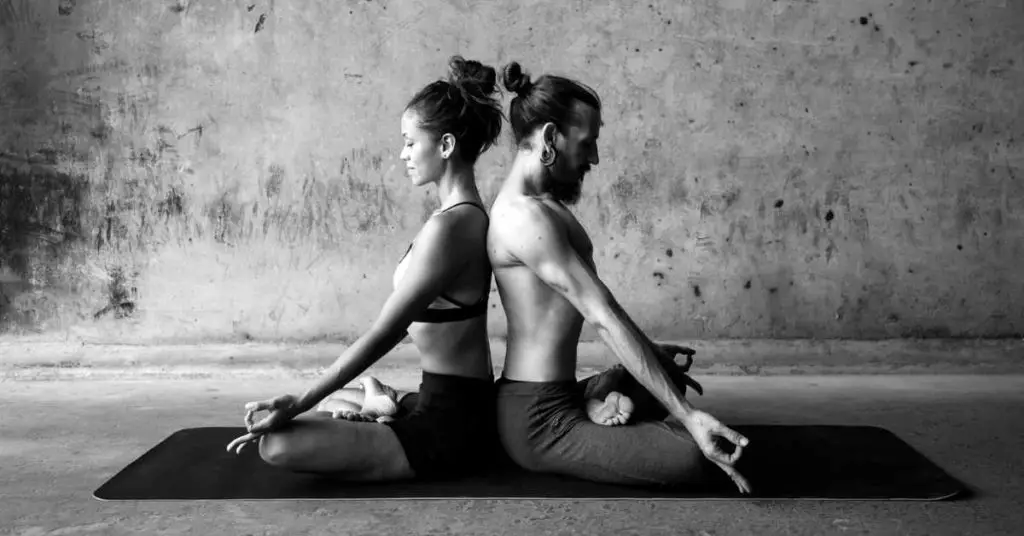Hey there, you beautiful humans! Today we’re diving into the wonderful world of meditation and whether it can actually help heal our precious little bodies.
Now, I know some of you might be thinking, “Meditation? That’s just sitting quietly and doing nothing, right?” Well, yes and no.
So, can meditation really help heal the body?
Yes, there is growing evidence to suggest that meditation can help promote healing in the body. Research has shown that meditation can have a wide range of physical and psychological benefits, including reducing stress and anxiety, improving sleep quality, and reducing chronic pain.
Meditation is a practice that has been around for thousands of years and involves training the mind to achieve a state of calm and relaxation.
It’s not just about sitting still and thinking about your to-do list (although I know that’s what I do sometimes!).
But seriously, it’s much more than that. It’s a way of cultivating mindfulness, improving focus, and reducing stress. And as it turns out, these benefits of meditation can also have a significant impact on physical healing.
And in this article, we’re going to explore the science behind this practice, different ways it can benefit physical health, and the best techniques to use for healing.
Ready to join me on this journey of self-discovery and mindfulness? Let’s get started!

The Science Behind Healing the Body Through Meditation
Okay, so we know that meditation can help reduce stress and potentially prevent or alleviate physical illnesses caused by stress. But how does it actually work?
To understand the science behind healing the body through meditation, we need to dive into the nervous system.
Our bodies have two main nervous systems – the sympathetic nervous system (SNS) and the parasympathetic nervous system (PNS). The SNS is responsible for our “fight or flight” response, while the PNS is responsible for our “rest and digest” response.
When we’re stressed, our SNS goes into overdrive, releasing adrenaline and cortisol. This can have negative effects on our physical health.
However, when we meditate, we activate our PNS, which helps to reduce stress and promote relaxation. This, in turn, can potentially lead to physical healing.
Additionally, research studies have shown that meditation can also have an impact on our immune system. A study published in the Journal of Alternative and Complementary Medicine found that participants who meditated had higher levels of antibodies in response to a flu vaccine compared to those who didn’t meditate.
This suggests that meditation may help boost our immune system and potentially prevent illness.
So, the science behind healing the body through meditation is pretty cool, huh?
By activating our PNS and potentially boosting our immune system, meditation can be a powerful tool in promoting physical healing.
What is the Best Meditation Technique to Heal the Body?
Meditation is a broad term that encompasses a variety of techniques, each with its own benefits and potential applications.
When it comes to healing the body, some meditation techniques may be more effective than others.
Here are a few examples of meditation techniques that are particularly beneficial for physical healing:
1. Body scan meditation:
This technique involves systematically scanning the body, starting at the feet and moving up to the head, to identify areas of tension or discomfort.
By focusing on these areas, we can potentially reduce pain and promote healing.
2. Loving-kindness meditation:
This technique involves sending feelings of compassion and love towards oneself and others. By cultivating positive emotions, we may be able to promote healing and recovery.
3. Mindfulness meditation:
This technique involves focusing on the present moment and accepting thoughts and feelings without judgment.
By practicing this technique, we can potentially reduce stress and anxiety, which can aid in the healing process.
When choosing a meditation technique to aid in healing, it’s essential to consider individual needs and preferences. Some people may find body scan meditation helpful, while others may prefer loving-kindness meditation.
It’s essential to experiment with different techniques and see what works best for you.
It’s also important to remember that meditation is not a substitute for medical treatment. While it may be a useful complementary therapy, it’s essential to follow medical advice and seek professional care when needed.
In conclusion, there is no one-size-fits-all answer to the question of the best meditation technique for healing the body.
However, by exploring different techniques and finding what works best for individual needs, we may be able to use meditation as a powerful tool in our journey towards physical healing and recovery.
How Mindfulness Meditation Can Improve Chronic Pain Management
Chronic pain is a persistent and debilitating condition that affects millions of people worldwide. Not only does it impact the body physically, but it can also take a toll on mental health, leading to anxiety and depression.
Fortunately, research has shown that mindfulness meditation can be an effective tool in managing chronic pain.
Multiple studies have found that mindfulness meditation can help reduce the intensity and frequency of chronic pain. For example, a study published in the Journal of Pain found that participants who practiced mindfulness meditation experienced a significant reduction in pain compared to those who didn’t meditate.
Another study published in the Journal of Behavioral Medicine found that participants who practiced mindfulness meditation had reduced pain sensitivity compared to those who didn’t meditate.
But how exactly does mindfulness meditation help with chronic pain management?
One theory is that mindfulness meditation can change the way the brain processes pain signals.
By focusing on the present moment and accepting pain without judgment, mindfulness meditation can help to reduce the emotional and mental suffering associated with chronic pain.
So, how can you incorporate mindfulness meditation into your chronic pain management routine? One technique is to simply focus on your breath and observe any sensations in your body, without trying to change or resist them.
This can help to shift your attention away from the pain and towards the present moment.
Another technique is to practice body scans, where you systematically scan through your body and observe any sensations you’re experiencing, without trying to change or judge them.
This can help to increase body awareness and reduce tension, which can in turn alleviate pain.
Overall, mindfulness meditation can be a powerful tool in managing chronic pain. By reducing pain intensity and frequency, and changing the way the brain processes pain signals, mindfulness meditation can improve both physical and mental well-being.

The Connection Between Meditation and Better Sleep, and How This Can Aid in Healing
Getting enough sleep is crucial for the body’s natural healing process. Sleep allows the body to repair damaged tissues and cells, regulate hormones, and consolidate memories.
Unfortunately, many people struggle with getting quality sleep, which can hinder the healing process. That’s where meditation can come in.
Several research studies have shown that meditation can improve sleep quality. For example, a study published in JAMA Internal Medicine found that participants who practiced mindfulness meditation experienced significant improvements in sleep quality compared to those who didn’t meditate.
Another study published in the Journal of Sleep Research found that participants who practiced meditation had less insomnia, less fatigue, and less depression compared to those who didn’t meditate.
So how exactly does meditation help with sleep? One theory is that it can help calm the mind and reduce stress, which can often be a root cause of sleep problems. By focusing on the breath or a mantra, meditation can help to quiet racing thoughts and promote relaxation.
Tips to start meditation to a better sleep
If you’re looking to incorporate meditation into your bedtime routine for better sleep, here are a few tips to get started:
- Set aside dedicated time for meditation before bed, even if it’s just a few minutes.
- Try different types of meditation to see what works best for you – for example, mindfulness meditation, loving-kindness meditation, or guided meditation.
- Create a relaxing environment for meditation, such as dimming the lights and using calming essential oils.
- Avoid using electronic devices right before bed, as they can interfere with sleep quality.
By incorporating meditation into your bedtime routine, you can improve sleep quality and support the body’s natural healing process.

The Potential Psychological Benefits of Meditation on Healing the Body
When it comes to healing the body, it’s important to remember that mental and physical health are closely connected.
Stress, anxiety, and other psychological factors can have a negative impact on physical health, and vice versa. That’s why meditation, which has been shown to have a positive impact on mental health, can also play a role in healing the body.
Research studies have shown that meditation can be effective in reducing symptoms of depression, anxiety, and stress. For example, a study published in JAMA Internal Medicine found that mindfulness meditation was as effective as antidepressant medication in reducing symptoms of depression.
Another study published in the Journal of Alternative and Complementary Medicine found that meditation was effective in reducing symptoms of anxiety and depression in cancer patients.
Improving mental health can also have a positive impact on physical healing. For example, stress has been shown to have a negative impact on wound healing, while positive emotions like happiness and relaxation have been shown to promote healing.
By reducing stress and improving mental health, meditation can help to promote physical healing as well.
If you’re looking to incorporate meditation into your healing routine for its potential psychological benefits, here are a few tips to get started:
- Choose a type of meditation that feels accessible and comfortable for you – for example, mindfulness meditation, loving-kindness meditation, or visualization meditation.
- Practice regularly, even if it’s just for a few minutes a day.
- Focus on the present moment and try to let go of any racing thoughts or worries.
- Be patient with yourself and don’t judge your meditation practice – remember, it’s a process and it takes time to develop.
By incorporating meditation into your healing routine, you can potentially improve your mental health and promote physical healing at the same time.
Understanding the Concept of Self-Healing Through Meditation and its Potential Applications
Self-healing through meditation is the concept of using meditation practices to tap into the body’s innate ability to heal itself. It’s based on the idea that the mind and body are closely connected, and that by calming the mind through meditation, we can help to activate the body’s natural healing processes.
There are many potential applications of self-healing through meditation. For example, it can be used to help alleviate symptoms of chronic illnesses like arthritis, asthma, and heart disease.
It can also be used to boost the immune system and promote overall health and well-being. Additionally, self-healing through meditation can be used as complementary therapy alongside conventional medical treatments.
If you’re interested in incorporating self-healing meditation practices into your daily life, here are a few tips to get started:
- Choose a quiet, comfortable space where you won’t be disturbed.
- Choose a type of meditation that feels accessible and comfortable for you – for example, body scan meditation, breath awareness meditation, or guided imagery meditation.
- Focus on your intention to heal and visualize yourself as healthy and whole.
- Practice regularly, even if it’s just for a few minutes a day.
By incorporating self-healing through meditation into your daily life, you can potentially tap into your body’s natural healing processes and promote overall health and well-being.
Can Meditation Heal Physical Injuries?
Physical injuries can be a significant obstacle to our daily lives, impacting our ability to move, work, and participate in activities we enjoy.
When we suffer an injury, our body undergoes a complex healing process, which involves inflammation, cell growth, and tissue repair.
Research studies have suggested that meditation may be able to aid in the physical injury healing process. For example, a study published in the Journal of Alternative and Complementary Medicine found that meditation may help to reduce pain and inflammation, which are key factors in the healing process.
Another study published in the Journal of Rehabilitation Medicine found that meditation can be effective in reducing stress and promoting relaxation, which can in turn aid in healing.
There are several meditation techniques that may be beneficial for physical injury healing, including:
- Body scan meditation: This technique involves systematically scanning the body, starting at the feet and moving up to the head, to identify areas of tension or discomfort.
By focusing on these areas, we can potentially reduce pain and promote healing.
- Visualization meditation: This technique involves visualizing the injury healing and imagining ourselves as healthy and whole.
By focusing our mind on this positive outcome, we may be able to promote healing and recovery.
- Breath awareness meditation: This technique involves focusing on the breath and using it as an anchor to stay present in the moment.
By practicing this technique, we can potentially reduce stress and anxiety, which can aid in the healing process.
While meditation is not a substitute for medical treatment, it may be a useful complementary therapy for those recovering from physical injuries. By reducing pain, inflammation, and stress, and promoting relaxation and a positive outlook, meditation may be able to aid in the healing process.

Conclusion
Meditation has been shown to have numerous benefits for physical healing, from reducing stress and anxiety to promoting better sleep quality and reducing chronic pain.
By incorporating meditation into a healthy lifestyle, individuals may be able to speed up the healing process and improve overall well-being.
While research on the potential of meditation in promoting physical healing is still ongoing, the evidence so far suggests that it can be a powerful complementary therapy for a wide range of conditions.
As we move forward, it’s essential to continue exploring the potential of meditation in promoting physical healing.
With further research, we may be able to identify specific meditation techniques that are particularly effective for different conditions and develop personalized meditation plans for individuals seeking to promote healing and recovery.
In the meantime, we encourage everyone to consider incorporating meditation into their daily routine as a way to promote overall well-being and support physical healing.
Whether it’s through body scan meditation, loving-kindness meditation, or another technique, the benefits of meditation are clear, and we should all take advantage of this powerful tool for healing and recovery.
Frequently Asked Questions
1. How long does it take for meditation to heal?
The healing timeline for meditation can vary depending on the individual’s health condition, severity of symptoms, and commitment to regular practice, but even short-term meditation practice can have positive effects on physical health.
2. Can meditation replace medical treatment for physical ailments?
While meditation can be a helpful tool for promoting healing and recovery, it should not be used as a replacement for medical treatment.
Individuals with physical ailments should always consult with a healthcare professional and follow their recommended treatment plan. Meditation can be used in conjunction with medical treatment to support overall well-being and promote healing.
3. What changes in body after meditation?
Meditation has been shown to have a number of positive effects on the body, including reducing stress and anxiety, lowering blood pressure, improving sleep quality, boosting immune function, and reducing inflammation. In addition, regular meditation practice has been linked to changes in brain structure and function, such as increased gray matter density in areas associated with attention and emotion regulation.











